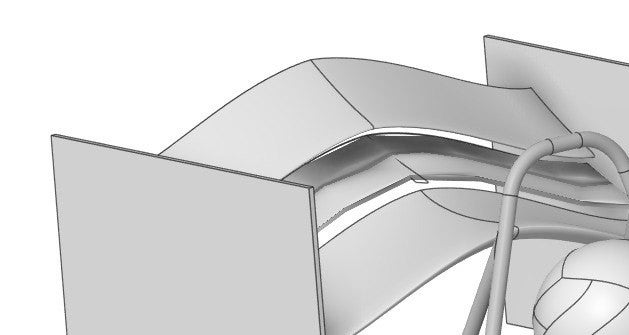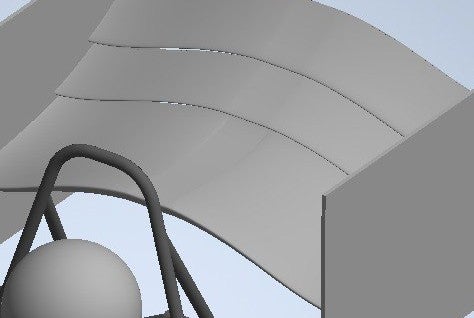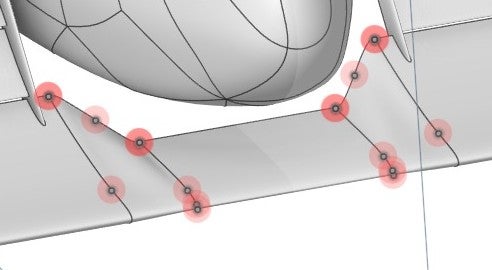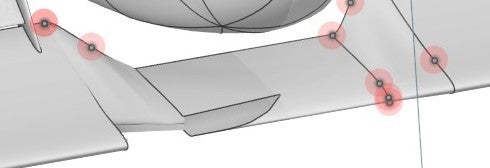TAGGED: cad-import, fluent, spaceclaim
-
-
September 16, 2025 at 10:36 am
fsae.unitn
SubscriberOur aerodynamics department has been facing some issues with Spaceclaim.
Our workflow is usually the following: we design all geometries in Inventor, then export them in STEP format to SpaceClaim, where we create the fluid volume before moving the geometry into Ansys Fluent.
The issue we are encountering is the following:
When we generate more complex geometries in Inventor using the loft function (which connects two sketches following a defined curve), some parts of the component—or sometimes the entire component—are lost after importing the geometry into SpaceClaim in STEP format.
The first picture shows the file in Inventor, and the second shows it in SpaceClaim. As you can see, the rear wing presents problems, and sometimes the geometry even disappears completely.
Can someone tell me how to fix the problem?
We were considering going back to the 2023 version, but we’re not sure if that would help.

Thank you in advice for your support
-
September 16, 2025 at 12:20 pm
peteroznewman
SubscriberI don’t know that this will help, but it is worth a try. Export a Parasolid file from Inventor and open that in SpaceClaim 2025.
- SpaceClaim 2025 uses a Parasolid kernel. When opening a Parasolid file, no translation of shape takes place.
- If you export a Parsolid from Inventor, only one translation of shape is done to open in SC2025: Inventor > Parasolid.
- Currently, you are seeing two translations: Inventor > STEP > Parasolid (in SC2025).
SpaceClaim 2023 uses an ACIS kernel, while Inventor uses a kernel that was forked from ACIS in 2001. If you have SpaceClaim 2023 installed, you can try opening the Inventor file directly. You can also try exporting an ACIS file (*.SAT) from Inventor and opening that in SpaceClaim 2023. There is reason to believe that this may result in a cleaner translation.
-
September 16, 2025 at 12:51 pm
fsae.unitn
SubscriberThank you for the answer. We've just tried with the same CAD, just by loading the '.x_t' file into Spaceclaim some parts are corrupted as we've already seen in previous images. We've tried to repair these with split edges function and also with inexact edges, some parts are correctly repaired, other instead are even worse. Another issue that we have, that may be correlated to this problem, is that when we try to create the enclosure some parts are excluded.
And also, when we use the split edges tool for repairing sometimes the geometry changes as shown in the pictures.

Thank you for supporting, we wait for a response.
-
September 16, 2025 at 7:33 pm
peteroznewman
SubscriberI have ANSYS 2023 R1 available to test your Inventor file if you would like to share the files. I will open your file in SpaceClaim 2023 R1 and check the results. If it comes out well, I can send the file back to you so you can open it in SpaceClaim 2025. Export an ACIS .SAT file from Inventor. If you are able to select the version of ACIS during export, select Version 7. Put the .SAT file as well as the original Inventor file into a folder and create a .zip file to compress the folder. Upload the .zip file to a file sharing site such as Google Drive and set the Sharing so that Anyone with the link can download it and put the link in your reply.
Note that when you are repairing using Split Edges, you can exclude the points that result in a bad outcome.
You can also take several translation paths into different documents then pick and choose the parts that translated most cleanly to copy into a final SpaceClaim document by selecting the solid bodies and typing Ctrl-C to copy the body, switching to the final document and typing Ctrl-V to paste the body.
-
September 17, 2025 at 9:05 am
fsae.unitn
SubscriberThank you for your availability. Last year we used Ansys 2023 R1 and we never had those kind of problems i showed to you. I can share to you the CAD, can you share me you mail? Or a way to contact you?
-
-
September 17, 2025 at 1:56 pm
peteroznewman
SubscriberIf you don’t mind making the file available to anyone, put the .SAT file as well as the original Inventor file into a folder and create a .zip file to compress the folder. Upload the .zip file to a file sharing site such as Google Drive and set the Sharing so that Anyone with the link can download it and put the link in your reply.
If you want to limit availability of the geometry, check back here after you post the link and when you see my reply, you can edit your reply to delete the link.
-
September 18, 2025 at 7:50 pm
fsae.unitn
SubscriberSorry, for the late respons. I was a little busy. This is the folder:
https://drive.google.com/file/d/1n2V9L88VQjn8-dAdw8foHAdmnicDBXSL/view?usp=drive_link -
September 20, 2025 at 7:36 pm
peteroznewman
SubscriberThe file is shared using the default Restricted setting so no one can download it without getting permission.
Please change the Sharing setting to Anyone with the Link can download, then I can take a look at the geometry in 2023 R1.
-
September 21, 2025 at 12:57 pm
fsae.unitn
SubscriberFixed
-
-
- You must be logged in to reply to this topic.


- Project lines/edges into a face with the direction normal to the face
- No preview in explorer with scdox file
- Multiple Instances of SpaceClaim taking multiple licenses
- Issues after installing new service pack 2024R1 (sp5)
- Add-in Error Excel
- Problems with loading my Discovery Mesh into Fluent
- Missing SubDivWrapper.dll
- Fileformats
- Discovery 2025r2 failed to initialize
- Spaceclaim problem

-
4177
-
1487
-
1363
-
1194
-
1021

© 2025 Copyright ANSYS, Inc. All rights reserved.







